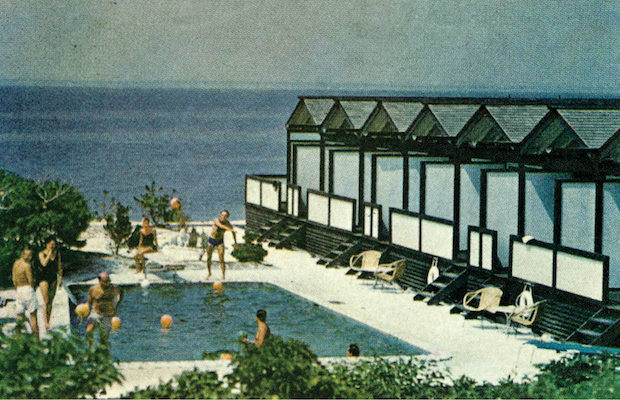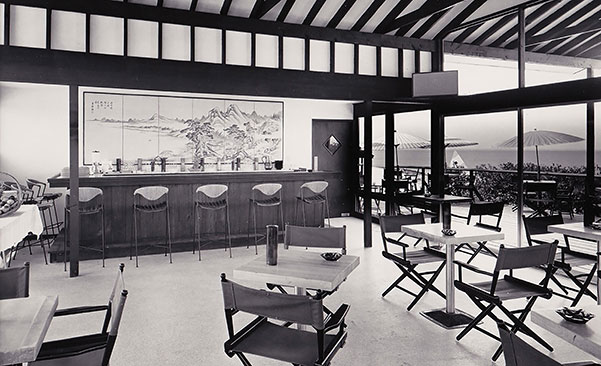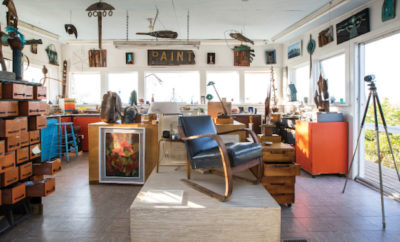 The retreat consisted of houses, cabanas, a clubhouse with a pool, and a marina and dock. | COURTESY FIRE ISLAND PINES HISTORICAL PRESERVATION SOCIETY, PINESHISTORY.ORG
The retreat consisted of houses, cabanas, a clubhouse with a pool, and a marina and dock. | COURTESY FIRE ISLAND PINES HISTORICAL PRESERVATION SOCIETY, PINESHISTORY.ORG
Feature
Suddenly Last Summer
NINETEEN-SIXTY MARKED THE FIRST summer at the Fire Island colony known as Talisman. John F. Kennedy was taking office in January of 1961, and the world was entering the age of the jet plane. Jackie and J.F.K. ignited a sense of glamour and style. They were home-grown American royalty as never before seen in the United States. And they were part of a sophisticated new world that was emerging in postwar America.
During the 1950s and early 1960s international jetsetters with cash and vision had begun developing playgrounds for the rich all around the world—such hot spots as Round Hill in Jamaica, the coasts of Beirut, Acapulco, Saint-Tropez, and more. Closer to home, Huntington Hartford, heir to the A&P supermarket fortune, began developing what was to become Paradise Island in the Bahamas in 1959. Hartford hired Palm Beach architect John Volk and created an old-moneyed grand resort that would open in 1962.
On New York’s Fire Island two significant new developments were underway. One was the stylish new gay community of the Pines that former male model John Whyte began developing on the harbor-side marina in 1962. And, just east of the Pines, the “new colony” of Talisman, where purchase of a home assured membership in the Talisman Yacht Club. Located on twelve acres about fifty miles from Manhattan, according to the New York Times of August 14, 1960, when completed, Talisman would house a clubhouse with a restaurant, bar, and pool; forty-plus cabanas; and twenty-four houses (two models available), each on a building plot measuring seventy-five by two hundred feet. At the time the article appeared there were four houses, the clubhouse and a pool, sixteen cabanas, and a marina to accommodate thirty boats. The houses were priced at $18,000 and $19,000 including the lot. Each had two bedrooms, a bath, kitchen, and a living room with a fireplace. The living room in the higher priced house was enclosed by glass on three sides. (Note: the 1960 census shows the average American home price was $11,900).
All of this was the brainchild of Broadway producer Michael Butler, an heir to the Butler paper and aviation fortunes of Chicago. In the late 1950s he had served as special advisor on the Middle East to then-Senator John F. Kennedy. His business partner for the project was Atlantic Records founder Ahmet Ertegun.
Butler designed the houses and cabanas. He’s quoted in The Last Sultan, Robert Greenfield’s biography of Ertegun, that in conceiving the design of Talisman he “wanted to create a club resort which was international in feeling, relaxed yet restrained.” The scheme was influenced by Japanese design principles. Both inside and out, all the structures expressed variations on the Zen principles of simplicity (kanso), naturalness (shizen), subtlety (yugen), and stillness or tranquility (seijaku). In the end, their modern pared-down look was reminiscent of Japanese teahouses.
The interiors were perfect examples of the 1960s modern beach house. Rush-matting rugs ruled—they were all the rage—inexpensive and casual, woven with subtle square patterns. There was furniture from McGuire and Mastercraft, the former, the go-to source for rattan in the 1960s, and the latter known for its Asian-inspired collections much in evidence at Talisman. Director’s chairs were everywhere, along with shoji screens, exposed wood beams, and big stereo speakers. It was simple, utilitarian, and chic. The outdoor areas were packed with easy-to-move, lightweight riveted-canvas and aluminum-framed chairs and loungers.
The clubhouse was designed by Long Island modernist architect Julian Neski, who worked with his wife, Barbara. Together they designed lyrical yet geometric beach houses that peppered the shores and resort communities of Long Island. The project that had put them on the map was the Chalif house in East Hampton— adjoining structures with steeply pitched, fin-shaped roofs that appear to open and close like scissor blades as one walks around the house. It was featured in Architectural Record, the New York Times Magazine, and Look magazine, and was exhibited at the World’s Fair in Osaka, Japan.
The clubhouse was the nucleus of Talisman, front and center when members and their guests arrived by private boat, water taxi, or seaplane. The boat dock sported myriad flagpoles, on which management flew the national flags of members. (Note: Fire Island is a barrier island located off the south shore of Long Island in New York. The island is thirty-two miles long and consists of seventeen communities. There are no paved roads in or between the communities and only service and emergency vehicles are allowed).
The social core of Talisman revolved around the trio of best friends: Butler, Ertegun, and Colombian businessman Julio Mario Santo Domingo. All three were hardworking, brilliant, and incredibly wealthy—with strong family pedigrees. And all were major playboys (married or not made no difference). They loved women and partying. Butler and Ertegun each owned one of the four houses—the other two were rented out. With just the four houses and sixteen cabanas, the number of weekend guests was limited to around forty. If you were not a pretty young thing you were most likely a part of the wealthy café society clique that consisted of old money, new money, and celebrity. The trio knew everybody— royalty, Hollywood celebrities, and musicians.
Talisman was about fun in the sun during the day—waterskiing, motorboats, snorkeling, swimming, hanging by the pool with a cigarette and drink in hand. At night the clubhouse was abuzz with eating, drinking, smoking, socializing, and dancing. One night in 1961 (the second summer) a guest who had just returned from Paris began doing what was referred to as a “weird dance.” Turns out she was doing the Twist, and everyone stayed up until dawn until they learned it; it was one of the first times the Twist was danced in the United States. Generally, the parties were themed—Calypso or Tahitian (luau parties were quite the rage). Conga lines would stretch from the clubhouse to the pool. Dress codes day or night were casual—and less was best. Men: shorts, swim trunks, maybe a top (boat shirts, T’s, button-down oxfords, or plaid or madras short sleeves), topped with a straw or bucket hat. Women: bikinis, wraps and cover-ups, large sunhats, big sunglasses, straw bags. The favorites were “Pucci simple.” The mood was a cross between the carefree hippie vibe of Ibiza and the moneyed glamour of Palm Beach.
Right before the second summer, in April 1961, Ertegun married his second wife, the super stylish Mica, a Romanian-born chicken farmer whose family members were wealthy landowners (her first husband had been part of the Romanian royal entourage). Then one weekend at Talisman, Ertegun met William “Billy” Rayner, a society man who was an assistant to the president at Condé Nast and whose wife, Chessy, was an editor at Vogue. Chessy was in Paris that weekend, but Billy couldn’t wait to introduce her to this “marvelous couple,” she recalled in a New York magazine piece a number of years later. Billy and Chessy introduced Ahmet and Mica to the fashion set, and Chessy and Mica became inseparable, lunching often and playing bridge every afternoon.
Eventually, though, Mica bored of all this and decided to study design. In 1967 she and Chessy started MAC II, the highly successful interior design firm. One of their first jobs was designing the New York apartment of their friend Julio Mario Santo Domingo. Before long they were decorating for the fashion set—Bill Blass’s penthouse and boutiques for Blass, Adolfo, and Geoffrey Beene.
Heading into the summer of 1961, Butler and Ertegun were probably aware that trouble was brewing on the horizon. After Kennedy became president, the executive branch became an avid proponent of both outdoor recreation and federal land acquisition. Kennedy sent a mandate to Congress entitled “Our Conservation Program,” and it soon became clear that expansion at Talisman was not going to be feasible. On September 3, 1964, President Lyndon Johnson signed the Wilderness Act, which allowed the Fire Island National Seashore to seize the land Talisman had been built on. Nineteen sixty-four was the last summer (the area was renamed Barrett Beach in 1965).
Today, fifty-two summers later, the structures still stand, weather-beaten remnants.
Doug Meyer is a designer and conceptual artist based in New York City.











